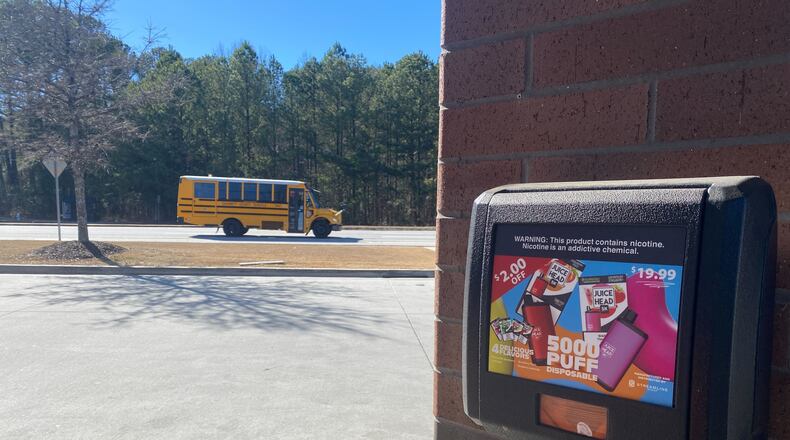Last March, a 12-year-old in southwest Georgia’s Lee County was hospitalized after using a vape pen laced with the potent drug fentanyl and THC, the psychoactive component in marijuana. A month later came reports out of Dalton that a 13-year old fell into a coma for weeks after using a vape that classmates gave him. Then a student in Lilburn overdosed from a drug-laced vape.
These incidents are the ones we hear about. But these extreme cases don’t paint the picture of how widespread vaping is among our children. As my colleague Josh Reyes recently reported, vaping violations are on the rise in Georgia’s public schools. Flavored vapes make up the most common category of substance use among middle and high school students across the state – more than alcohol, leaf tobacco or other drugs.
Nationally, the percent of high school students using vapes, also known as e-cigarettes, was 10%. Among middle school students, 4.6% vape, according to the Annual National Youth Tobacco Survey from the Food and Drug Administration (FDA).
Vaping, for those who don’t know (and plenty of people don’t), involves inhaling an aerosol from devices that may look like cigarettes, pens or other common items. The aerosol is produced when a liquid containing nicotine, flavors and other chemicals is heated. The user then inhales the aerosol into their lungs. The devices may also be used to inhale marijuana and other drugs.
Vapes laced with fentanyl may result from unintentional cross contamination, or the drug may be intentionally added to create a more potent product that ultimately increases profits of the supplier, according to some health care professionals.
The products, whether laced with fentanyl or not, can be harmful to your health and can lead to other types of substance abuse. “We have been successful at reducing kids smoking and de-normalizing smoking,” said Lucy Popova, associate professor at Georgia State University’s School of Public Health. “When e-cigarettes came … kids who wouldn’t have picked up a tobacco product would pick up an e-cigarette.”
The majority of young users (almost 90%) use e-cigarettes with sweet flavors such as fruit, candy or desserts. The products are marketed to them via social media. Preventing the sale of flavored products has been a large part of the strategy to reduce vaping among kids.
The FDA began regulating e-cigarettes as tobacco in 2016, but years of limited enforcement gave companies a lot of leeway and loopholes. When the agency began to crackdown on vaping around 2019, it was playing catch-up on the 27 million vaping products that existed on the market.
This reminded me of that moment in the 1980s when clove cigarettes were the rage. Kids at my middle school thought the cigarettes made with tobacco, menthol and ground cloves were less toxic than standard nicotine products. Then we learned clove cigarettes weren’t as harmless as we thought, sometimes resulting in severe illness to young people who were attracted to the sweet flavor and cool packaging.
While selling flavored e-cigarettes is largely illegal in the U.S., there is more that needs to be done.
Schools are just microcosms of the larger community, and vaping is considered a public health crisis, said Popova. Much of the efforts to address the crisis has been directed at children, such as the 2021 state law requiring public schools to teach about risks associated with vaping. The legal smoking age was raised to 21. Some schools have instituted punishments for kids who are caught vaping, but punishment is not an effective deterrent.
The FDA needs to step up its review of e-cigarettes coming to market and its efforts to remove illegal and unauthorized products that are already on the market. Parents need to engage their children in conversations about the health risks of nicotine, the role vaping plays in addiction and the danger of purchasing unauthorized products.
Popova wonders why retailers who are selling illegal vaping devices don’t feel more compassion for their customers. “That has been puzzling to me,” she said.
I wonder, too. But that’s the reason we need a more comprehensive approach.
Cigarette smoking has been declining for years. But “it took a lot more to get where we are now,” Popova said. “It took policy, smoke-free laws and assistance provided to people to help them quit.”
In June, a new law added vaping to Georgia’s smoke-free air act. If you can’t smoke in a certain location, you also can’t vape in that location.
Last week, a state bill began winding its way through the legislature that would give Georgia agencies authority to establish a directory of nicotine vapor products authorized for sale in the state and prohibit the sale of any product that is not listed in that directory.
Some opponents of the bill argue that passage of the law would put independent vape shops out of business, force people to return to combustible cigarettes or prevent cigarette smokers from quitting.
But, to me, that sounds like they’re just blowing smoke.
Read more on the Real Life blog (www.ajc.com/opinion/real-life-blog/) and find Nedra on Facebook (www.facebook.com/AJCRealLifeColumn) and Twitter (@nrhoneajc) or email her at nedra.rhone@ajc.com.
About the Author
Keep Reading
The Latest
Featured



